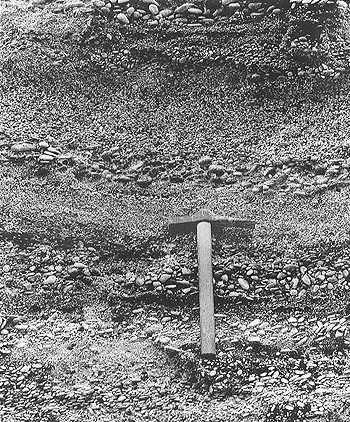
Organized conglomerate
Plate 62

Organized conglomerate
Plate 62
Rudites, including gravel (loose) and conglomerate (cemented), are the coarsest sedimentary deposits. They are frequently structureless, but even when they are present, bedding and structures are recognizable with more difficulty than in sands and sandstones. Bedding surfaces are often crude, rougher, and ill-defined; they are related to vertical changes in one or more textural parameters, such as grain size (average, maximum, range, and variability), shape and roundness, packing (closeness or spatial density), orientation and fabric, and type and amount of matrix (finer materials occupying spaces between pebbles).
In the picture, bedding is emphasized mostly by marked differences in grain size of pebbles. The pebbles are closely packed, which means that there is little room available for matrix or cement between them. A certain degree of cementation, however, occurred; it allows the maintenance of a vertical cliff, and the description of the sediment as a conglomerate.
The beds have a certain lateral continuity, at least within the limits of the picture frame; an exception is made by two small lenticular units near the top. The lenses have a concave base and a flat top, indicating that they represent the fill of local scours. Such lenticular beds of very limited lateral extent are also called pockets.
The picture is a close-up view of the clinostratified body illustrated in plate 14 (gravel pit in Pleistocene littoral deposits of Marche Region, Italy).
In general, rudites are qualified as organized when a certain order, structure or organization of constituent particles can be recognized in them, disorganized when they look like randomly heaped stones.1 As said before, organization is shown by textural characters and fabric, for example sorting by size or shape, alignments or clustering of pebbles (see plates 66, 67), or particular orientations of pebbles (plates 64, 65).
Note 1: R. G. Walker. 1975. Generalized facies models for resedimented conglomerates of turbidite association. Bull. Geol. Soc. Amer. 86: 737-748. Back.